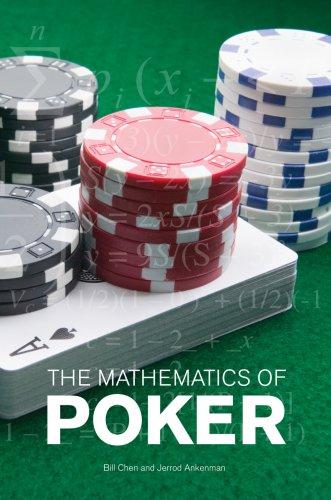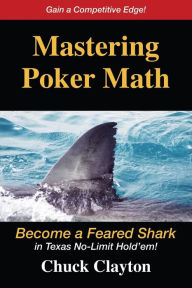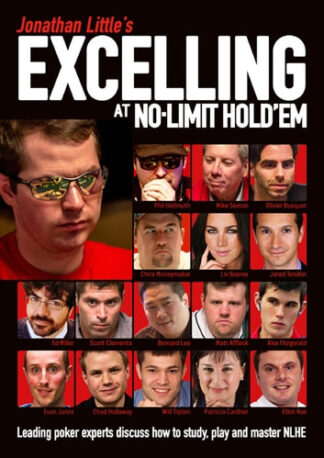The Mathematics of Poker
Average price online: $27.68
Based on The Cover
Traditional poker players used to rely on intuition and reading opponents’ tells. Over the last decades, a new breed of poker players has emerged, challenging old assumptions and utilizing computer science and mathematics to gain an edge. This book aims to introduce quantitative techniques and game theory as applied to poker, making seemingly complex mathematical concepts accessible to players without an extensive math background.
A Review of The Book by Jaime Staples
TL;DR Important Takeaways From The First Few Chapters
- Value betting and bluffing frequencies in optimal poker strategies are directly related through the ratio α = 1/(P+1), where P is the pot size. By bluffing a fraction α of their range, the bettor makes the opponent indifferent between calling and folding.
- α is also the optimal folding frequency for the caller against bluffs. By folding a fraction α of their calling range, the caller makes the bettor indifferent between value betting and bluffing.
- Balancing value bets with bluffs at the proper frequencies ensures the bettor extracts value regardless of how the opponent plays – if they fold too much, bluffs get value; if they call too much, value bets get value.
- In games where one player has no strategic decisions, the other player should simply maximize their own expectation.
- Optimal strategies are only truly indifferent at the thresholds between actions. Often the worst bluffs have positive expectation compared to checking.
- In games with infinite strategy spaces like [0,1] games, optimal strategies involve pure strategy regions separated by indifference thresholds rather than mixed strategies over individual hands.
- The process for solving [0,1] games involves guessing a parameterization for the strategy structure, deriving indifference equations at the thresholds, solving for the threshold values, and verifying the solution is indeed optimal.
- As pot sizes grow larger, players should tighten their value betting ranges and decrease their bluffing frequencies in order to remain unexploitable.
The key insights revolve around the mathematical relationships between value betting, bluffing, and folding frequencies that allow strategies to be balanced and unexploitable in simplified poker games.
What We Learned
From reading this text, we learned several new concepts related to the mathematics and game theory of poker that we were new to us:
- The specific mathematical relationship between pot size, bluffing frequency (α = 1/(P+1)), and optimal folding frequency against bluffs (also α) in simple half-street poker games.
- The idea of solving for optimal strategies in [0,1] poker games by guessing a parameterization of the strategy structure, deriving indifference equations at the thresholds between actions, and solving those equations.
- The notion that in optimal strategies, players are only truly indifferent between actions at the threshold hands, while hands far from the thresholds can have positive or negative expectation compared to the alternative action.
- The importance of balancing value bets and bluffs at specific frequencies to prevent exploitation by the opponent folder too much or calling too much.
- How the values of α and the betting/folding frequencies change as the pot size grows, with players tightening their value ranges and decreasing bluff frequencies for larger pots.
- The mathematical framework and terminology for analyzing these simplified poker games, like the use of [0,1] hand distributions, parameterizations, indifference equations, thresholds between actions, etc.
While we had some basic knowledge of game theory concepts like mixed strategies before, this book provided much more mathematical depth and poker-specific applications. It opens up an entire new framework for rigorously analyzing optimal poker strategies in simplified games.



